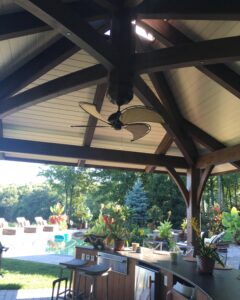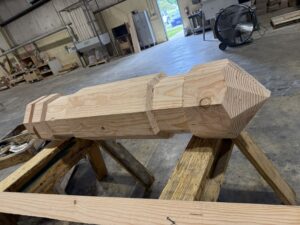Timbercraft Hand-Cut Boss Pins: Precision at the Heart of Every Roof
In traditional timber framing, every joint tells a story — of design, structure, and care. Among the most intricate and essential of these details is the boss pin — the central, vertical post that anchors multiple roof or brace timbers together. At Timbercraft, we take special pride in hand cutting and dry fitting each boss pin, ensuring strength, precision, and beauty that lasts for generations.
What Is a Boss Pin?
A boss pin serves as the central connecting point in complex roof designs — especially in hip roofs, hexagonal or octagonal frames, and other structures where multiple rafters or braces converge. Think of it as the heart of the roof frame: a vertical post (often similar to a king post) that brings all the radiating timbers together in perfect alignment.
In a hip or multi-sided roof, each timber must meet the boss pin at precisely the right angle. Even a fraction of a degree off can affect the geometry of the entire structure. That’s why precision and craftsmanship are absolutely critical.
What the Boss Pin Does
The boss pin provides structural integrity and alignment. It:
-
Acts as a central hub connecting roof timbers or braces.
-
Distributes loads evenly, preventing twisting or shifting over time.
-
Enhances the symmetry and strength of complex roof systems.
-
Serves as a visual and structural centerpiece — often left exposed as part of the timber frame’s beauty.
In short, the boss pin is both functional and aesthetic — a master joinery element that embodies the art and science of timber framing.

Why Hand Cutting Matters
At Timbercraft, every boss pin is hand cut and dry fitted before assembly. This step isn’t just tradition — it’s precision in practice.
-
Exact Fit: Each timber is individually scribed and shaped to meet the boss pin perfectly. Hand cutting allows for subtle adjustments that machines can’t replicate.
-
Tight Joints: Properly hand-fitted joinery ensures tight, durable connections that won’t loosen over time.
-
Craftsmanship: Our framers’ hands and eyes guide the process, preserving the authenticity and artistry of traditional joinery techniques.
-
Quality Control: Dry fitting allows us to assemble the joinery in the shop, confirming that every angle, shoulder, and peg hole aligns before final installation on site.
The Importance of Dry Fitting
Before the timber frame is installed, each component is dry fitted — meaning assembled without glue or pegs — to ensure perfect alignment. This process reveals how the structure will fit together and allows fine adjustments while the frame is still accessible in the shop.
For a boss pin, dry fitting is especially critical. With so many timbers converging at one point, absolute accuracy is essential to ensure the structure comes together smoothly on installation day. When everything fits perfectly in the shop, the frame assembles beautifully on site — just as it was designed.
Craftsmanship You Can See
Every Timbercraft frame reflects a balance of tradition and precision. Hand-cut boss pins aren’t just about connecting timbers — they’re about connecting craft, structure, and pride. When you look up at a Timbercraft roof and see those beams radiating from a central post, you’re seeing the result of generations of timber framing knowledge — measured, cut, and fitted by hand.
